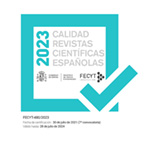Representación de la historia del antiguo Irán en el discurso del primer rey Pahlavi (1925-1941) para construir una identidad territorial en el marco del concepto de gubernamentalidad
Resumen
En el marco de la idea de gubernamentalidad, la identidad territorial consiste en un conjunto de símbolos y procedimientos que se expresan en un determinado período de la historia y se les da precedencia sobre otros símbolos. Según esta perspectiva, la identidad nacional no es solo un fenómeno natural sino algo que el estamento político construye a lo largo del tiempo y se estabiliza como una memoria comunitaria, con la posibilidad de que sea reconstruida en el futuro. El objetivo de la investigación actual es examinar cómo se desarrolló la identidad territorial iraní durante la era del primer Pahlavi, de 1925 a 1941, utilizando el marco teórico del discurso de la gubernamentalidad. Los hallazgos indican que la construcción de la identidad nacional en la era del primer Pahlavi se ha basado en la interpretación unificadora de la historia del antiguo Irán en la dirección de la solidaridad de los grupos étnicos y las clases sociales. Según este supuesto, el liderazgo carismático era lo único que podía garantizar la justicia espacial entre los diversos grupos étnicos y sociales. A través de la adaptación al espacio de la nación y del territorio, este elemento también podría estabilizar la identidad territorial del pueblo iraní.
Descargas
Descarga artículo
Licencia
La revista Geopolítica(s). Revista de estudios sobre espacio y poder, para fomentar el intercambio global del conocimiento, facilita el acceso sin restricciones a sus contenidos desde el momento de su publicación en la presente edición electrónica, y por eso es una revista de acceso abierto. Los originales publicados en esta revista son propiedad de la Universidad Complutense de Madrid y es obligatorio citar su procedencia en cualquier reproducción total o parcial. Todos los contenidos se distribuyen bajo una licencia de uso y distribución Creative Commons Reconocimiento 4.0 (CC BY 4.0). Esta circunstancia ha de hacerse constar expresamente de esta forma cuando sea necesario. Puede consultar la versión informativa y el texto legal de la licencia.









